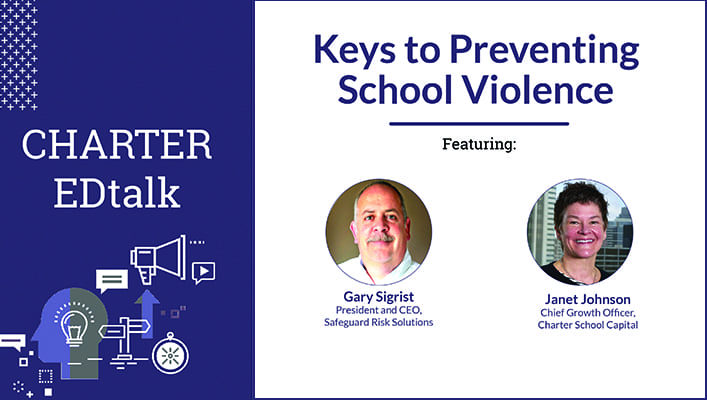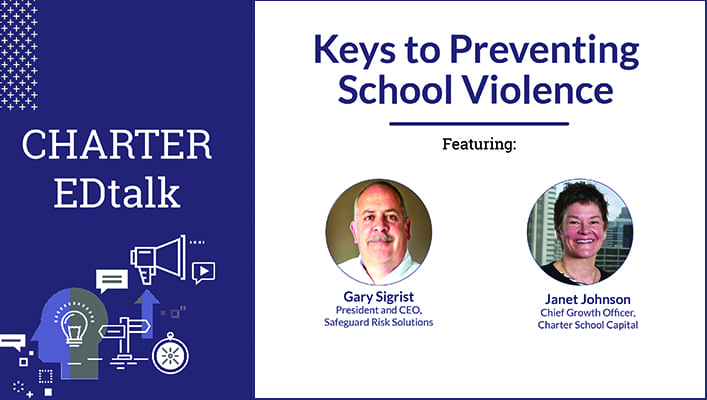Charter School Security: Keys to Preventing School Violence
In this CHARTER EDtalk, Janet Johnson, Charter School Capital’s Chief Growth Officer, had the honor of sitting down with school safety expert, Gary Sigrist, President and CEO, Safeguard Risk Solutions.
Gary Sigrist is a nationally known speaker, consultant, author and expert on emergency preparedness. His career spans more than 30 years as an educator, administrator and police officer. Sigrist’s background in both education and law enforcement gives him a unique perspective on safety and preparedness, which he brings to his work with clients of Safeguard Risk Solutions.
We were so pleased that Gary took some time to share his insights and some simple tips on how to build a positive school culture and how that can, in turn, help prevent school violence. Watch the video and read the complete transcript below.
TRANSCRIPT:
Janet Johnson: Good day. This is Janet Johnson. I’m with Charter School Capital and we’re fortunate enough to be here today with Gary Sigrist from Safeguard Risk Solutions, talking about a pretty topical subject that can be a little bit nerve-wracking, which is school security.
Gary Sigrist: Yes. Good morning.
Johnson: Good morning and thank you for joining us.
Sigrist: Glad to be here.
Johnson: We really appreciate it. We thought we’d talk a little bit about school security and frankly, I think the question that most people really want to know is how do we prevent issues from happening?
Sigrist: So there’s a wide range of things you can do, and almost all of them are inexpensive, which is important. It’s the prevention aspect. In the United States, we spend about $6 billion a year on school safety and security, and most of it is response. Whereas with prevention, if you’re in the response phase, you’re already that school. Okay. So if we’re in the prevention phase, it’ll never happen. You’ll never get that negative recognition.
And prevention as everything from a positive school culture to having threat assessment teams, to just making sure that all of your students are engaged in your school. And that more than anything, that engagement where they feel like they belong, will prevent them from doing things because they want to get back at someone. Or they’re on a pathway to justification that it’s okay that I do this to you because you did this to me, or a pathway to violence. So, in that prevention phase, you keep that student engaged in the school because then they don’t want to harm the school or anybody in it because they belong to that school.
Johnson: And so when you are on this path to prevention through the students, that’s teachers, right? Are you talking about teachers, mostly?
Sigrist: It is going to have to be driven actually from the administrators who are creating that positive school climate with their staff. Because it’s not just teachers. It’s cooks, it’s custodians, it’s the secretary, it’s everybody who creates this positive school climate where … there’s never going to be a day where a student is going to say, “Yippity, I get to come to school today.” But you don’t want them to get up in the morning and say, “Oh my God, I don’t know if I can take another day there.”
So if they are engaged with the school, because every adult in that building sees and smiles, welcomes them, and creates that positive “I’m glad you’re here” feeling, that’s going to help reduce it. We’re also going to have to make sure that there’s no culture of bullying. Where kids know that they feel accepted.
When you talk about this pathway of violence, pathway of justification, it’s a dynamic process. A child may actually be on a pathway, but if you intervene, help that child change their circumstances, they get off that pathway. So you can control what happens in your school simply by controlling the culture of your school.
Johnson: So how do you establish the positive culture?
Sigrist: Well, one of the things that I think is so easy is during class changes, when you’re talking about middle school and high school, because that’s when your most likely offender is going to be out, teachers should be out in the hallway. And they’re out in the hallway for a lot of reasons. One is they can manage the students. If they see bullying behavior, they can stop it. If they see behavior that’s not acceptable, they can stop it.
But they can also engage the students as they see them in the hallway. “Hi, how are you doing? Nice job on your math test. Really liked you in the play yesterday. Looking forward to the school concert.” All those things that make the students feel like they belong. And they set the tone for that positive school climate.
We know that children are less likely to make a mistake if they have a caring adult in their home, their neighborhood, their church or their school. And so the school is a very big part of that, of making that child feel like they belong and they’re part of the school.
Johnson: So sometimes just a smile and a comment.
Yet positive school climate is the least expensive and the most effective thing you could do to keep your students and staff safe.
Sigrist: Just a smile, and the thing is, money is tight in every school. Yet positive school climate is the least expensive and the most effective thing you could do to keep your students and staff safe.
Johnson: Are there resources that you would recommend for school leaders to look at, establishing this positive climate that are accessible to folks?
Sigrist: There are thousands of resources online. One of my favorite resources is the United States Department of Education and the REMS Technical Assistance Center, the REMS TA center. They have everything that you might consider for helping your school remain safe, and all of those resources are free, which is huge. They’ll even come out and do free training.
Johnson: Really?
Sigrist: So it’s the REMS TA center. You just Google REMS, Readiness and Emergency Management Schools TA, technical assistance center, and you’ll pop up with blogs that you can go to. There are exercises, there are memorandums of understanding it, everything they lay out for what schools need to be safe. They have emergency operation plans that are free, that almost every state requires. So to me, if you’re looking for free resources that have the backing of the United States Department of Education, the REMS technical center is the place to go.
Johnson: That’s the place. And we will post the link to that in our blog. So please visit us and take a look at that. So positive school culture. Let’s talk about preventing bullying a little bit if you don’t mind.
Sigrist: You know, that’s, unfortunately, one of the areas we have to look for bullying first is within our staff.
Johnson: Really?
Sigrist: I can see a lot of that kind of behavior. I hear a lot of that behavior where teachers bully or are not being kind to each other. And your students will model that behavior. So-
Johnson: That’s a surprise to me.
Sigrist: Statistically 20, I always, when I’m giving a presentation, I’ll ask how many people have been bullied when they were in school? A lot of people raise their hand. And I say, where are those bullies now? And statistically, 25% are in prison or jail. So where are the other 75%? They’re in the workplace. And so if you don’t address that behavior, if staff members were being negative towards each other, then as an administrator, you’re going to have to address that because that’s unacceptable behavior.
And I’ve seen in my teaching career, teachers throw other teachers, for lack of a better word, under the bus in front of the students.
Johnson: Really?
Sigrist: And so the students say, “Well, if it’s okay for that teacher to pick on that teacher, why is it not okay for me to pick on that student?” So modeling that positive behavior of what you want to see.
Johnson: Wow. I’m surprised.
Sigrist: Most people are.
Johnson: No kidding. Are there any other just quick hints in terms of the positive school culture and climate?
Sigrist: No. I think it’s just an easy thing. You set up methods to recognize your students whenever they do well, and you reward them for doing good things.
Johnson: That’s right. That’s fabulous. Gary, thank you so much.
Sigrist: You’re welcome.
Johnson: Appreciate it.
Sigrist: Alrighty.
To learn more about school safety and security, check out this webinar-on-demand. In it, we cover important topics around safety and security for schools, specifically looking at security challenges in charter schools. Access the slides and recording of this webinar to learn about school safety measures, emergency planning, threat assessment, and more.

